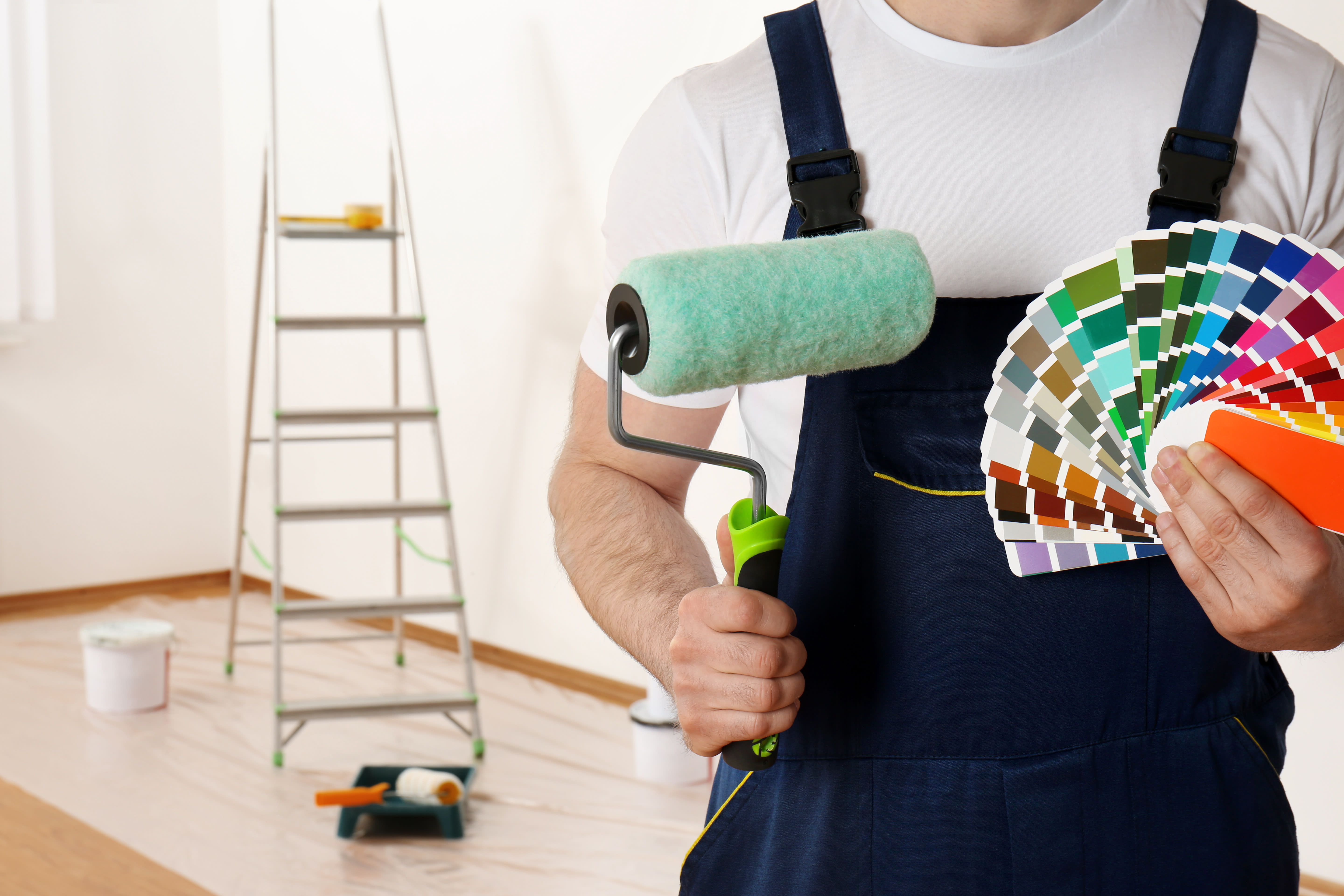Exploring the Various Sorts Of Paint: An Overview for each Project
Checking out the various sorts of paint is crucial for attaining the wanted outcome in any kind of job. From water-based choices that provide benefit to oil-based paints recognized for their longevity, each selection has its merits. Specialty paints can add special textures or coatings, while environment-friendly alternatives satisfy those seeking sustainability. Recognizing these differences can significantly influence the success of a paint undertaking. What aspects should one consider when making the right option?
Comprehending Paint Types: Oil-Based vs. water-based
Paint types can markedly affect a job's end result, and understanding the differences in between water-based and oil-based paints is necessary for notified decision-making. Water-based paints, often described as latex paints, are composed of water as the main solvent. They completely dry quickly, send out fewer unpredictable natural compounds (VOCs), and are easy to clean up with soap and water. This makes them a prominent option for indoor applications and settings where air top quality is a worry.
On the other hand, oil-based paints utilize natural solvents, giving a resilient, glossy surface suitable for surfaces exposed to tear and use, such as trim and closets. They take longer to completely dry, need mineral spirits for clean-up, and have a more powerful odor. corpus christi tx paint shop. Choosing in between these two kinds depends on the specific requirements of the job, thinking about factors such as desired surface, application atmosphere, and simplicity of maintenance. Each type has distinct advantages and constraints, leading the selection process
The Finish Issues: Selecting Between Matte, Satin, and Gloss
When picking a paint finish, the option in between matte and glossy choices considerably affects both aesthetics and functionality. Matte coatings use a refined, non-reflective appearance that can conceal surface area flaws, while glossy finishes give durability and convenience of cleansing. Comprehending the benefits and considerations of each can aid in making a notified decision for any kind of paint project.
Matte Finish Advantages
Numerous property owners debate the merits of numerous surfaces, matte paint offers distinctive advantages that make it a preferred choice for both indoor and outside applications. One of the key benefits of matte coating is its capability to hide surface blemishes, developing a smoother appearance on wall surfaces. This top quality is especially advantageous in older homes or spaces with unequal surfaces. In addition, matte paint takes in light instead than showing it, which can boost the aesthetic of a room by supplying a more innovative and muted appearance. Moreover, matte surfaces are often simpler to touch up than glossier choices, as they can mix much more flawlessly when used over existing paint. In general, matte paint is a superb choice for those looking for an improved and sophisticated surface.
Glossy Complete Considerations
A glossy surface can significantly change the understanding of an area, using a reflective and sleek top quality that boosts both shade vibrancy and light within an area. This coating is often favored for high-traffic areas and surface areas like bathroom and kitchens, where longevity and convenience of cleansing are important. Its reflective nature can highlight blemishes on wall surfaces, making correct surface area preparation essential. Glossy paints likewise have a tendency to show fingerprints and smudges quicker, demanding normal maintenance. Additionally, lighting plays a significant role; in bright environments, a shiny coating may create glare, influencing the total visual. As a result, cautious consideration of the specific application and atmosphere is necessary when choosing a glossy coating for any type of job.
Specialized Paints: When to Utilize Textured or Chalk Paint
Specialized paints, such as distinctive and chalk paint, offer special aesthetic and sensible advantages that can boost numerous surface areas. Distinctive paint is optimal for creating deepness and dimension on wall surfaces, hiding blemishes while including a three-dimensional feel. It is particularly helpful in high-traffic areas where longevity and visual passion are essential.

Both sorts of specialty paints can transform spaces, but choosing the right one relies on the preferred effect and surface area needs. Distinctive paint might match bigger areas, while chalk paint can revitalize smaller sized products, showcasing creative thinking and individual style in any type of job.
Exterior Paints: Shielding Your Surfaces From the Elements
Exterior paints are essential for guarding surface areas versus numerous weather problems. Understanding their weather resistance attributes, correct surface area preparation requirements, and efficient application strategies can significantly enhance longevity and efficiency. This area will certainly lay out essential considerations for choose and making use of exterior paints properly.
Weather Resistance Features
Weather condition resistance is an important function of exterior paints, as it determines just how well surface areas can withstand the severe aspects of nature. High-quality exterior paints helpful resources are formulated to withstand damages from UV rays, dampness, and temperature level fluctuations. UV resistance warranties shades stay lively over time, stopping fading and discoloration. Dampness resistance shields against mold and mold, which can endanger the stability of surface areas. Additionally, paints with superb temperature level resistance can expand and acquire without breaking, keeping their protective high qualities. When choosing outdoor paints, it is essential to take into consideration these climate resistance functions, as they add to the long life and durability of coloured surfaces, making sure they stay visually pleasing and practical in spite of direct exposure to the elements.
Surface Area Prep Work Needs
Proper surface area preparation is an essential action in achieving the very best outcomes with outside paints. To guarantee suitable bond and longevity, surfaces need to be completely cleaned, eliminating dust, mold, and oil. This can be completed using a stress washing machine or a scrub brush with an ideal cleansing option. Once cleaned, surfaces should be examined for any peeling or flaking paint, which must be scraped away to create a smooth foundation. Repairing any kind of openings or splits is additionally necessary, as these can allow moisture seepage. Furthermore, sanding harsh areas advertises far better paint bond. Applying a guide suited for outdoor usage can improve the paint's efficiency, guaranteeing a durable coating that stands up to the components. Correct prep work is key to a successful outdoor paint job.
Application Methods Tips
While applying outside paints, it is important to make use of effective strategies that guarantee surfaces are well-protected versus the elements. Select the right day for paint; reduced moisture and mild temperatures enhance bond and drying out. Prepping the surface completely-- cleansing, sanding, and priming-- makes sure better paint attachment and longevity. Utilizing high-quality brushes or rollers can provide a smoother finish, while spray paint might cover huge locations effectively. Applying paint in thin, even coats prevents runs and drips. It is advisable to comply with producer directions concerning drying out times between coats. Validate correct ventilation during application to help with drying and lessen exposure to fumes. These strategies substantially improve the durability and efficiency of outside paint.
Eco-Friendly Options: Low-VOC and Zero-VOC Paints
As consumers become progressively aware of the environmental impact of their choices, zero-voc and low-voc paints have become popular choices. These paints are formulated to have fewer unstable organic substances (VOCs), which are chemicals that can evaporate right into the air and add to air pollution and illness. Low-VOC paints usually include a restricted amount of VOCs, while zero-VOC paints have negligible degrees, making them safer for both indoor and outside use.
The advantages of making use of low-VOC and zero-VOC paints extend past environmental considerations; they also boost indoor air high quality, reducing the danger of respiratory problems and allergic responses. Lots of makers currently supply a range of shades and finishes in environmentally friendly choices, making it easier for consumers to locate ideal items for their jobs. By selecting these paints, people can add to a healthier environment while still attaining the aesthetic they desire in their areas.
Devices and Strategies for a Remarkable Application
Attaining a perfect paint application requires the right tools and techniques, which can significantly boost the result. Selecting the appropriate brush or roller is essential; brushes work well for edges and detailed areas, while rollers cover bigger surface areas effectively. Using high-quality products guarantees far better paint circulation and lessens touches. For suitable outcomes, surface area prep work is vital. This includes cleaning, fining sand, and priming surfaces to promote adhesion.
Strategy likewise plays a considerable duty. The "W" approach with a roller helps to evenly distribute paint, while long, smooth strokes with a brush avoid visible lines. Operating in areas enables for far better control and blending. Additionally, using thin layers is better to thick layers, lowering the risk of drips and unequal structures. Keeping a damp edge during application aids achieve seamless read this modifications in between areas. By incorporating these devices and techniques, one can attain a specialist and polished finish.
Tips for Maintaining and Caring for Your Painted Surfaces
Appropriate upkeep and treatment of painted surface areas can substantially extend their lifespan and protect their look. Normal cleansing is essential; utilizing a soft fabric or sponge with light soap and water can get rid of dirt and dust without harming the paint. It is suggested to stay clear of unpleasant cleaners or scrubbing pads, as these can damage the surface area. Furthermore, applying a fresh coat of paint every couple of years can protect and revitalize the color against wear.
For outside surfaces, inspecting for signs of peeling or fading regularly is important. Quickly dealing with any type of problems stops additional damage. In areas vulnerable to dampness, such as shower rooms, using mold-resistant paint and ensuring correct ventilation can help keep the honesty of the paint. Lastly, using protective coatings can protect against UV rays and spots, guaranteeing that painted surfaces continue to be attractive and vivid for many years ahead, eventually enhancing the total visual of the room.
Often Asked Inquiries
Can I Mix Different Types of Paint Together?
Mixing various kinds of paint is typically not recommended, as it can lead to issues like bad adhesion, inconsistent appearance, or unanticipated chain reaction. It's best to utilize compatible paints for ideal outcomes and longevity.

How Do I Appropriately Shop Surplus Paint?
To properly store leftover paint, secure the container snugly, label it with the date and color, and maintain it in an awesome, dry location far from straight sunlight and extreme temperature levels for ideal conservation.
What Is the Ideal Way to Dispose of Unused Paint?
The finest means to deal with unused paint is to inspect regional policies, as numerous locations have assigned harmful waste centers. Additionally, consider contributing functional paint to community companies or schools for their projects.
Just How Can I Inform if Paint Is Still Excellent to Use?
To determine if paint is still excellent, analyze its shade, scent, and uniformity. If it shows up apart, has an unpleasant odor, or shows significant modifications in structure, it's most likely no longer usable.
Are There Age Restrictions for Getting Paint Products?
In lots of regions, there are no particular age restrictions for purchasing paint products. Some stores might need clients to be at the very least 18 years old, specifically for items having solvents or hazardous products.
Paint types can noticeably affect a project's end result, and comprehending the differences between water-based and oil-based paints is vital for informed decision-making. Water-based paints, commonly referred to as latex paints, are see here composed of water as the main solvent. In comparison, oil-based paints use organic solvents, giving a resilient, shiny coating ideal for surfaces subjected to tear and put on, such as trim and closets. Specialty paints, such as textured and chalk paint, offer one-of-a-kind visual and useful advantages that can improve various surface areas. In areas prone to dampness, such as bathrooms, utilizing mold-resistant paint and ensuring proper ventilation can aid maintain the stability of the paint.